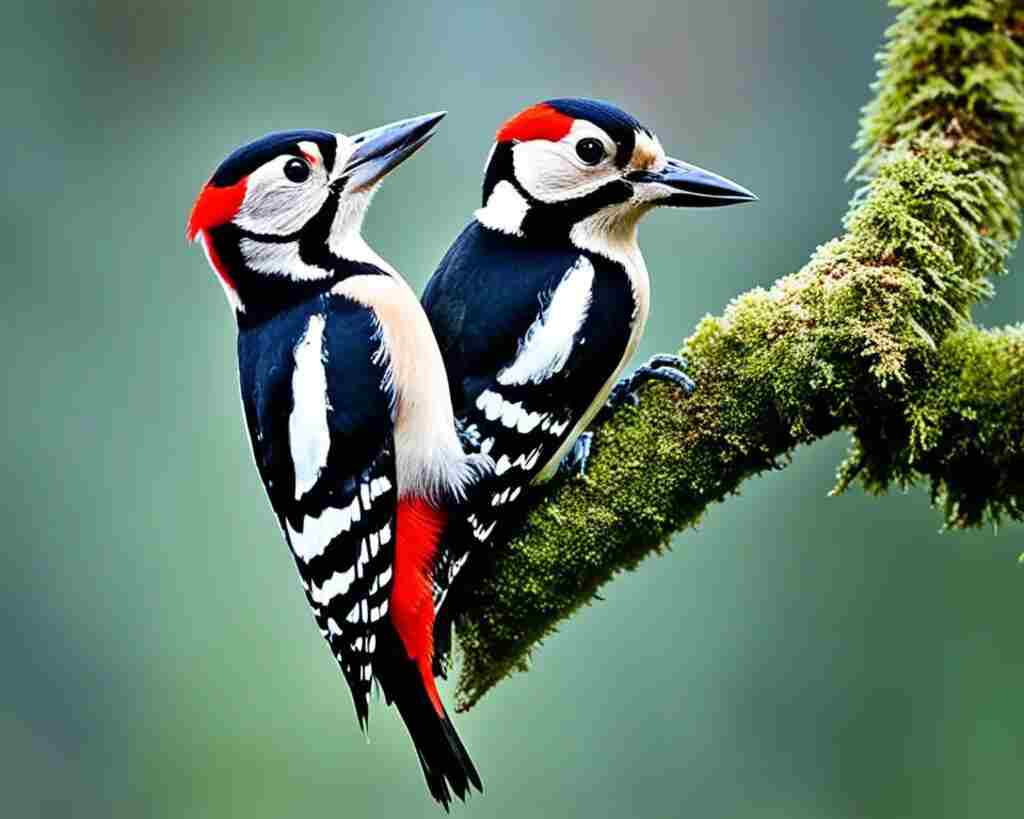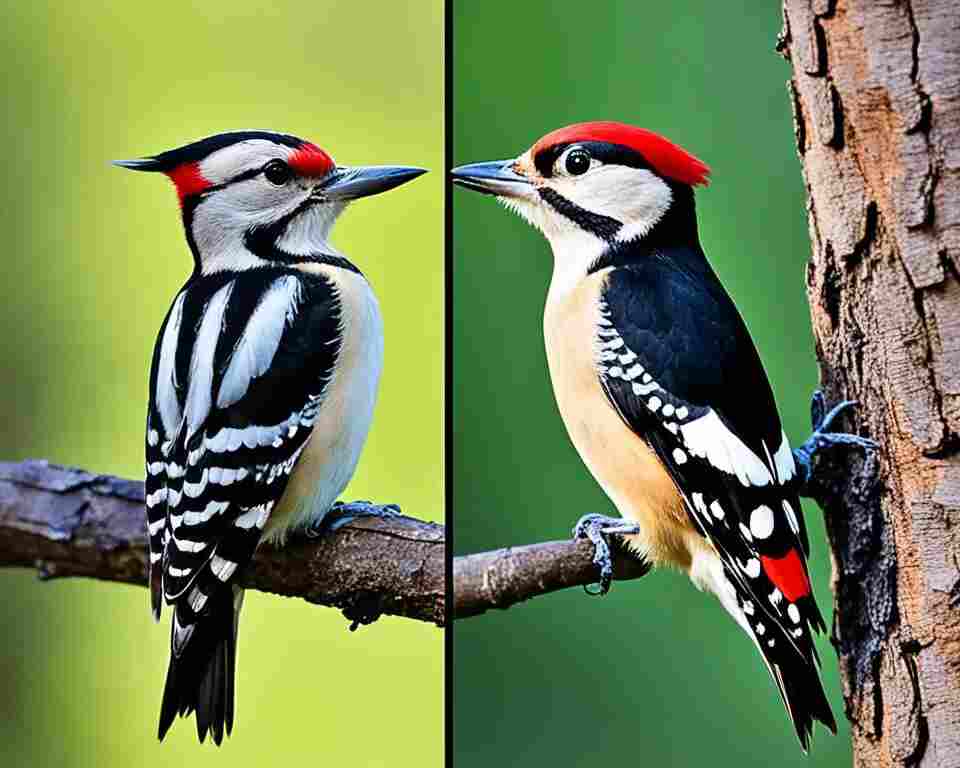Did you know that male and female great spotted woodpeckers display distinct physical characteristics and behaviors that can help identify their gender? These fascinating birds exhibit sexual dimorphism, making it possible to differentiate between males and females. In this article, I will provide essential tips for identifying the sex of a great spotted woodpecker, allowing you to appreciate their beauty and behavior in a whole new way.
Table of Contents
Key Takeaways:
- Male and female great spotted woodpeckers can be distinguished by their physical characteristics and behaviors.
- Understanding sexual dimorphism is crucial for accurately identifying the sex of a great spotted woodpecker.
- Observing plumage, size, and behavioral differences can help determine the gender of these birds.
- Factors such as nesting habits, dietary preferences, and courtship rituals can further aid in identifying male and female great spotted woodpeckers.
- Enhance your birdwatching experience by confidently differentiating between male and female great spotted woodpeckers.
Understanding the Sexual Dimorphism of Great Spotted Woodpeckers
Great spotted woodpeckers exhibit sexual dimorphism, which refers to the visible differences between males and females of the species. These differences can be observed in their plumage, size, and behaviors, providing valuable clues for accurately identifying the sex of a great spotted woodpecker.
The Striking Contrast in Plumage: Spotting the Differences
One of the key ways to distinguish between male and female great spotted woodpeckers is through their plumage. Males typically have distinct black and white patterns on their feathers, often with a red patch on the back of their heads. In contrast, females have a similar pattern but lack the red patch. The difference in plumage can be easily spotted, making it an important characteristic for identification.
Size Similarities: Breaking the Myths of Sexual Size Dimorphism
While sexual dimorphism is commonly associated with differences in size between males and females, great spotted woodpeckers challenge this notion. Both male and female woodpeckers have similar sizes, making it more challenging to differentiate based on size alone. As a result, plumage and behaviors play a more significant role in determining the sex of these birds.
Behavioral Nuances Between the Sexes
In addition to plumage, behavioral differences also exist between male and female Great-spotted woodpeckers. Males are known for their drumming behavior, which they use to establish territories and attract mates. They produce a distinct, repetitive sound by rapidly pecking on trees. Females, on the other hand, exhibit more secretive behaviors when nesting and foraging. Understanding these behavioral nuances can provide further insights into identifying the sex of great spotted woodpeckers.
| Characteristics | Male | Female |
|---|---|---|
| Plumage | Distinct black and white patterns Red patch on the back of the head | Similar black and white patterns as males No red patch on the back of the head |
| Size | Similar to females | Similar to males |
| Behavior | Drumming behavior for territorial display Distinctive, repetitive pecking on trees | More secretive nesting and foraging behaviors |
How can you tell if a Great Spotted Woodpecker is male or female
Identifying the sex of a Great Spotted Woodpecker requires careful observation of their physical characteristics and behaviors. By examining key traits, birdwatchers can confidently determine whether a woodpecker is male or female.
One notable characteristic to observe is the plumage. Male and female Great Spotted Woodpeckers have different patterns and coloration. Males typically have a red patch on the back of their heads, extending down their neck, while females lack this feature. Additionally, males often have a red undertail, which is absent in females. These distinct differences in plumage are reliable indicators of the woodpecker’s sex.
Another aspect to consider is the behavior. Males are known to engage in drumming, a behavior where they rapidly peck on wood to create a loud sound. They do this to attract mates and establish their territory. Females, on the other hand, may exhibit more nest-building and foraging behaviors.
Observing these physical characteristics and behaviors can greatly aid in determining the sex of a Great Spotted Woodpecker. By combining these observations with other identification techniques, such as size and vocalizations, birdwatchers can confidently identify male and female Great Spotted Woodpeckers in the wild.
In the table below, you can find a visual summary of the distinguishing features between male and female Great Spotted Woodpeckers:
| Characteristic | Male | Female |
|---|---|---|
| Head Plumage | Red patch on the back of the head and neck | Lacks red patch |
| Undertail | Red undertail feathers | Lacks red undertail feathers |
| Drumming Behavior | Engages in frequent drumming | May exhibit more nest-building and foraging behaviors |
Identifying Male and Female Great Spotted Woodpeckers in the Wild
In order to accurately identify male and female great spotted woodpeckers, it is important to understand the various aspects of their behavior that differ between the sexes. By examining nesting habits, dietary preferences, and courtship rituals, birdwatchers can gain a comprehensive understanding of how to differentiate between male and female great spotted woodpeckers in the wild.
Nesting Habits: A Collaboration between Genders
Great spotted woodpeckers exhibit cooperative nesting behaviors, with both males and females playing an active role in creating and maintaining their nests. Nesting habits of great spotted woodpeckers involve excavating cavities in trees using their strong beaks. These cavities serve as their nesting sites and are essential for raising their young. The male and female will work together to construct the nest, taking turns in digging the cavity and keeping the entrance clean to ensure its optimal condition.
Dietary Preferences and Foraging Behaviors
The dietary preferences of great spotted woodpeckers vary slightly between males and females. While both sexes primarily feed on insects, the female tends to focus more on the larvae found beneath the bark of trees, while the male will often target adult insects. This difference in foraging behaviors helps to ensure a diverse and abundant food supply for their nestlings. Both male and female great spotted woodpeckers will also consume various fruits, nuts, and seeds, supplementing their diet with additional resources.
Courtship and Parental Roles Distinguished by Gender
During courtship, male great spotted woodpeckers engage in elaborate displays to attract a female mate. They may perform drumming displays on resonant objects to demonstrate their strength and fitness. Once a pair has formed, the female takes on the role of incubating the eggs while the male provides food for her during this period. After hatching, both the male and female play crucial roles in feeding and caring for the hatchlings until they fledge. Courtship and parental roles in great spotted woodpeckers clearly show the collaboration and shared responsibilities between the sexes.
By understanding these male and female great spotted woodpecker characteristics, nesting habits, dietary preferences, and courtship and parental roles, birdwatchers can enhance their ability to identify and appreciate these fascinating birds in their natural habitats.
Conclusion
In summary, accurately identifying the sex of a great spotted woodpecker requires keen observation of both their physical characteristics and behaviors. By understanding the sexual dimorphism and key traits exhibited by each gender, birdwatchers can confidently differentiate between male and female great spotted woodpeckers.
This knowledge not only enhances the birdwatching experience but also contributes to a deeper appreciation and understanding of these fascinating creatures. The distinct differences in plumage, size, and behaviors between males and females provide valuable insights into their biology and ecology.
By paying close attention to nesting habits, dietary preferences, and courtship rituals, birdwatchers can gather crucial information about these birds’ ecology and contribute to broader research efforts. Furthermore, accurately identifying the sex of great spotted woodpeckers contributes to citizen science initiatives and helps researchers monitor populations and understand population dynamics.



